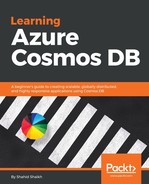Book Description
Gain an in-depth understanding of Azure Cosmos DB - a multi-model database from Microsoft
About This Book- Develop your skills to build and scale applications using the power of Azure CosmosDB.
- Learn how to store and access data with a variety of APIs including MongoDB, Gremlin, SQL, Azure Tables and much more.
- Fast paced guide to have a better understanding of the features with the practical approach mentioned.
This book is intended to anyone who wants to get well versed with Microsoft's new NoSQL database called Azure Cosmos DB. Get the database into work with the practical examples mentioned.
What You Will Learn- Build highly responsive and mission-critical applications
- Understand how distributed databases are important for global scale and low latency
- Understand how to write globally distributed applications the right way
- Implement comprehensive SLAs for throughput, latency, consistency, and availability
- Implement multiple data models and popular APIs for accessing and querying data
- Implement best practices covering data security in order to detect, prevent and respond to database breaches
Microsoft has introduced a new globally distributed database, called Azure Cosmos DB. It is a superset of Microsoft's existing NoSQL Document DB service. Azure Cosmos DB enables you to scale throughput and storage elastically and independently across any number of Azure's geographic regions.
This book is a must-have for anyone who wants to get introduced to the world of Cosmos DB. This book will focus on building globally-distributed applications without the hassle of complex, multiple datacenter configurations. This book will shed light on how Cosmos DB offers multimodal NoSQL database capabilities in the cloud at a scale that is one product with different database engines, such as key-value, document, graph, and wide column store. We will cover detailed practical examples on how to create a CRUD application using Cosmos DB with a frontend framework of your choice. This book will empower developers to choose their favorite database engines to perform integration, along with other systems that utilize the most popular languages, such as Node.js. This book will take you through the tips and trick, of Cosmos DB deployment, management, and the security offered by Azure Cosmos DB in order to detect, prevent, and respond to database breaches.
By the end of this book, you will not only be aware of the best capabilities of relational and non-relational databases, but you will also be able to build scalable, globally distributed, and highly responsive applications.
Style and approachAzure Cosmos DB is the first and only globally distributed database service in the industry today to offer comprehensive Service Level Agreements (SLAs) encompassing all four dimensions of global distributions which our customers care the most: throughput, latency at the 99th percentile, availability, and consistency. As a cloud service, we have carefully designed and engineered Azure Cosmos DB with multi-tenancy and global distribution in mind.
